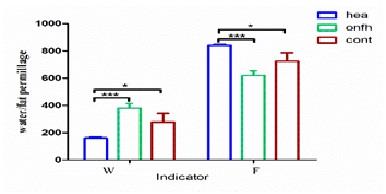bing xie1, jingjing li1, jie wang1, mingshan du1, wei chen1, Xiaoyue zhou2, Panli zuo3, and Xiaodong zhong
1radiology, Southwest Hospital, Third Military Medical University, chongqing, People's Republic of China, 2MR Collaboration, Siemens Healthcare Ltd, shanghai, People's Republic of China, 3MR Collaboration, Siemens Healthcare Ltd, beijing, People's Republic of China
Synopsis
Avascular necrosis of thefemoral head (ANFH)
is a pathological process that results from interrupted or impaired blood
supply to bone. The multi-echo 3D Dixon technique provides the
water/fat ratio quantification for evaluation of the bone marrow edema and the
stage of ANFH. Our study demonstrated that femoral head water/fat permillage in
ANFH was significantly higher than that of the healthy hips.
Objective
Avascular necrosis of the femoral
head (ANFH) is a pathological process that results from interrupted
or impaired blood supply to bone, involving osteocyte and bone marrow component
death and subsequent repair. ANFH ultimately leads to structural changes,
collapse, and dysfunction of the femoral head. Semi-quantitative scoring is an
established method for evaluating ANFH magnetic resonance imaging (MRI)
datasets in observational studies and clinical trials. Advanced quantitative MRI
techniques may improve the assessment of femoral head composition.The Dixon MR imaging sequence can be used for characterization of musculoskeletal
pathologies by calculating the water/fat ratio of the femoral head. In our study,
we assessed ANFH using Dixon MR imaging by detecting the changes in femoral head water/fat
ratio.Material and Methods
Twenty ANFH patients (11
males, 9 females, age 21-58, average age 39) and 22 healthy people with matched
age and gender were included in this
study. The primary symptoms in ANFH patients were hip joint pain, tenderness,
and radiating pain. All patient cases were confirmed with femoral head necrosis by conventional MR imaging
findings.MRI data
were collected on a MAGNETOM Trio 3T MR scanner (Siemens) with a 6-channel body
matrix Coil. The multi-echo3D Dixon sequence (TR = 9.1ms, TE =1.23, 2.48, 3.73, 4.98,
6.23, 7.48ms, voxel size: 2.0×1.6×2.0mm3, FOV:400×400mm2) was used to measure the water/fat ratio of
femoral head.The water/fat permillage of the femoral head was calculated.A double factor variance analysis was performed
to compare femoral head water/fat
permillage between ANFH patients and the healthy controls.Results
Of
the 20 ANFH patients (40 joints), there were 8 cases with bilateral
osteonecrosis and 12 cases with unilateral osteonecrosis. The 40 joints were
divided into an osteonecrosis of the femoral head (ONFH) group (28 joints) and a
contralateral (CONT) group (12 joints). 44 joints in the healthy group (HEA) were
also observed. Differences in water/fat permillage between the three groups were
statistically significant (F=9.58, p=0.000,
η2=0.19). The water/fat permillage of the ONFH group was significantly
higher than that of the HEA group. The fat permillage of the ONFH group was significantly
lower than that of the HEA group (Fig.1).Discussion
Radiographic studies are limited to the
depiction of joint space and of cancellous subchondral bone changes. Often, T2-weighted
images aid in the detection of necrotic tissue for ANFH lesions that mostly
show ill-delimited edema-like marrow changes. Semi-quantitative assessment is a
widely accepted method for evaluating large MRI datasets in observational
clinical trials of the hip. The multi-echo 3D Dixon technique provides the water/fat
ratio quantification for evaluation of the bone marrow edema and the stage of
ANFH. Our study demonstrated that femoral head water/fat permillage in ANFH was
significantly higher than that of the healthy hips. The findings demonstrated that the measurements of femoral head bone
marrow edema can be used to describe ANFH at the early stage.Conclusion
The multi-echo 3D Dixon MR imaging provides
a promising method of measuring femoral head water/fat permillage in ANFH
patients. This technique reliably describes femoral
head bone marrow edema and may improve
the diagnostic accuracy for ANFH.Acknowledgements
No acknowledgement found.References
Zhong
X, Nickel MD, Kannengiesser SAR, Dale BM, Kiefer B, Bashir MR. Liver fat
quantification using a multi-step adaptive fitting approach with multi-echo GRE
imaging.MagnReson Med 2014;72:1353-1365.
